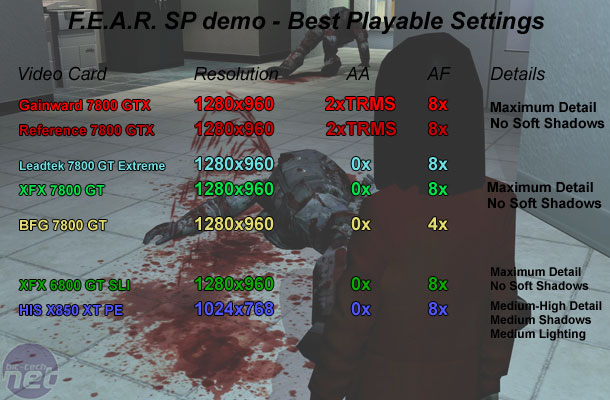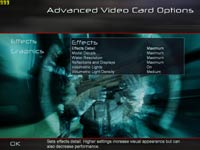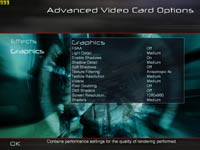Leadtek 7800 GT and ForceWare 78.03
September 29, 2005 | 17:40

F.E.A.R. - single player demo
Publisher: VU GamesWe used the F.E.A.R. public demo, as it is on course to become the most intensive shooter of 2005. The game makes use of a lot of shadows - including soft shadows, volumetric lighting, parallax mapping and particle effects along with a slow-motion mode that really taxes today's top of the line GPU's. There's extensive use of high resolution textures. The walls are both bump mapped and parallax mapped to give a realistic feel to the brick walls that are a big feature of this title. Also, the world is incredibly destructible, which is made more realistic by parallax mapping.
In general, this is a graphically intense game and the most outstanding part of the graphics engine is undoubtedly the player character's shadow that is cast on the wall.
It also has the most advanced A.I. that we have ever seen in a game engine to date - there are times when you'll find yourself with your pants down around your ankles with no where to go. For anyone who hasn't played this demo yet, it's well worth a look - check out our F.E.A.R. preview here.
Anti-Aliasing and Anisotropic Filtering were controlled from inside the game, and thus drivers were left set to "Application Controlled".
Below is a table of the best-playable settings that we found best for each video card configuration. We decided that a minimum frame rate of around 15 frames per second and an average of over 55 frames per second would deliver the best-possible gaming experience on these mid-range cards. This was not what we would call creamy smooth gaming, but it was about as smooth as possible given the issues we were having in achieving smooth game play with 1GB of memory.

The minimum frame rate increased by a good four frames per second, taking it from 14 frames per second to 18 frames per second. This meant that the game was a lot smoother with ForceWare 78.03. We also saw a two frames per second increase in the average frame rate. All in all, the ForceWare 78.03 drivers worked very well in this title.

MSI MPG Velox 100R Chassis Review
October 14 2021 | 15:04







Want to comment? Please log in.